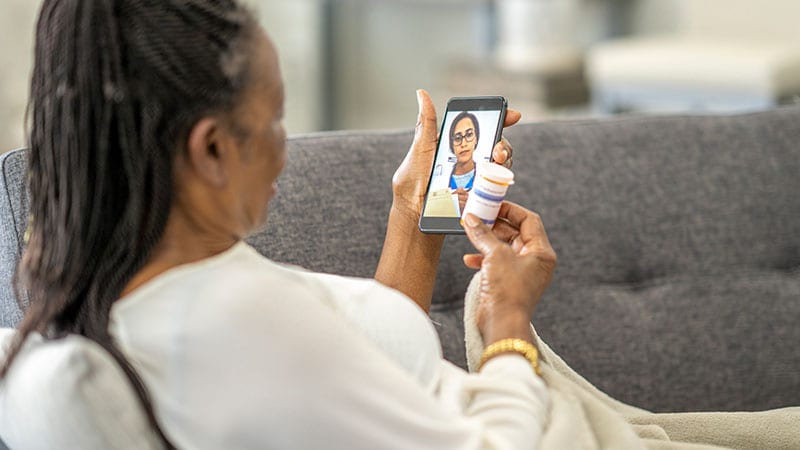COVID-19 forced consumers to adopt digital and virtual platforms to receive medical care, and more than 2 years after the start of the pandemic, it doesn’t appear that that will change.
“During the pandemic we witnessed a very steep rise in the utilization of digital healthcare transactions. And as we have now witnessed a plateau, we see that digital healthcare transactions have not fallen back to the way things were prepandemic,” said Bart M. Demaerschalk, MD, professor and chair of cerebrovascular diseases for digital health research at the Mayo Clinic in Phoenix, Arizona. “At Mayo Clinic and other healthcare organizations, approximately 20%…of the composite care is occurring by digital means.”
Demaerschalk was among a panel representing retail and traditional healthcare organizations at the American Telemedicine Association conference in Boston.
The pandemic created this new reality, and healthcare leaders are now trying to make the most of all digital tools. Marcus Osborne, former senior vice president at Walmart Health, said that to progress, the healthcare industry needs to move beyond the conception of a world in which consumers interact with care providers via one-off in-person or digital experiences.
“What we’re actually seeing in other sectors and in life in general is that the world is not multichannel. The world is omnichannel,” Osborne said. Under an omnichannel paradigm, provider organizations integrate multiple digital and in-person health delivery methods, making it possible to “create whole new experiences for consumers that no one channel could deliver,” he added.

Dr Creagh Milford
Creagh Milford, DO, vice president and head of enterprise virtual care at CVS Health, agreed and added that “the retail footprint will evolve” from offering separate physical and virtual care experiences to a “blended” experience.
To move in this direction, healthcare leaders need to “stop talking about the site of care so much,” said Christopher McCann, CEO and co-founder of the health IT firm Current Health. Instead of “fixating” on either brick-and-mortar or digital experiences, leaders should meet “the consumer where they are and deliver what is the most appropriate care to that consumer in the most appropriate setting,” McCann said.
Three Key Digital Technology Strategies
In addition to supporting an omnichannel experience, the panelists pointed out that traditional and retail healthcare providers can make the most of digital technologies in a few different ways.
One is by helping consumers manage innovation. With venture capital investments in digital technologies at an all-time high, the healthcare industry is drowning in innovation, Osborne pointed out.

Marcus Osborne
“So on one hand, we have been blessed with this eruption of innovation. On the other hand ― and I’m saying this as a consumer ― it [doesn’t] really matter. I’m overwhelmed, and I think the market is overwhelmed,” Osborne said. “So if we’re overwhelmed, it means we’re not going to leverage that innovation as effectively as we should be.” The challenge, then, is to find a way to “not get overwhelmed by the sheer force of innovations occurring” and to instead leverage these new technologies to drive real transformation in our healthcare system.
To meet this challenge, healthcare organizations will have to provide consumers with “some guidance as to how to tailor that journey,” Demaerschalk said. “It’s the responsibility of all of us to be creating that tailored and individual guidance for our patients.” By doing so, healthcare organizations ultimately can help consumers feel less overwhelmed.
Another strategy is to ensure that the use of technology promotes health equity. Osborne pointed out that events such as the pandemic and George Floyd’s murder have resulted in a “much more robust conversation around the need to address health inequities in America. I’ve also heard a lot of people say they believe that digital health solutions are the answer.”
As such, healthcare organizations need to ensure that digital innovations are leveraged to “fundamentally address the inequities that we’re facing today and support the care of all Americans,” Osborne noted.
To move in this direction, leaders need to address one glaring gap: “We talk all the time about fancy technology, like artificial intelligence. Most of my clients, they’re just trying to get basic internet access at home,” McCann said. “So, there’s a technology challenge we first have to solve.”
Once this hurdle is overcome, however, digital technologies could pay off in spades, especially for consumers who struggle to access in-person services because they live 2 or 3 hours away from the hospital, are working two jobs, and have childcare responsibilities, McCann noted.
Healthcare must also address staffing issues, said the panelists. Leaders need to create new career paths for clinicians as digital care delivery becomes more prominent.
Some healthcare organizations have already discovered that using digital technologies to support hospital-at-home programs can also enhance the work lives of clinicians.
When working in hospital-at-home programs, clinicians can “deliver care in the way that they have always wanted to but have never been able to within an acute inpatient facility. They’re able to go into patients’ homes and spend an hour with them, actually develop a proper relationship and look at social determinants of health and medications and do things in a way they’ve never been able to do before. And that has dramatically reduced rates of burnout,” McCann said.
While these strategies will help organizations support “this exciting digital ecosystem,” healthcare technology innovators need to “really study the costs and the health outcomes related to these digital health transactions in order to move the entire field and the science forward,” Demaerschalk concluded.
John McCormack is a Riverside, Illinois–based freelance writer covering healthcare information technology, policy, and clinical care issues.
For more news, follow Medscape on Facebook, Twitter, Instagram, and YouTube.
Source: Read Full Article
